Aug 2021
31
What happens if you don't submit Revenue’s Employer Eligibility Review Form?
The Irish government has extended the Employment Wage Subsidy Scheme (EWSS) until 31st December 2021. The scheme gives employers impacted by COVID-19, a subsidy per employee to help keep them in employment. On 9 July, Revenue published guidelines to highlight the changes to the EWSS applicable for the period from 1 July 2021. The main change made to the scheme was in relation to eligibility.
To assist employers in ensuring continued eligibility for the scheme, from 30th June 2021, all employers are required to complete and submit an online monthly EWSS Eligibility Review Form (ERF) through ROS by the 15th of each month. Companies claiming EWSS must fill out a monthly eligibility form, showing their revenue for 2021 remains at least 30% below the reference period in 2019 and a declaration to confirm that the information submitted is correct and accurate to the best of their knowledge. Failure to complete and submit the EWSS Eligibility Review Form that confirms the required reduction and related declaration will result in suspension of payment of EWSS claims.
Revenue has stated: “Where Revenue determines that an employer, at any time over the term of the scheme, claimed and received payment by applying accounting practices that are clearly not appropriate, or by deliberately misrepresenting the true financial situation of the business, it will be excluded from the EWSS in its entirety. No further claims will be accepted, and all subsidy paid and PRSI credit issued will be immediately repayable together with interest and penalties. The business may also face possible criminal prosecution.”
The government has paid nearly €4 billion to date in EWSS payments on top of the €2.9 billion paid under the earlier TWSS. Revenue have launched an investigation on companies that are suspected of overclaiming pandemic wage subsidies.
According to Revenue’s code of practice for audits and non-audit interventions, officials can make unannounced site visits, conduct profile interviews with business owners, carry out assurance checks, and initiate investigations. Please ensure you are submitting correct information to avoid any penalties.
Upcoming webinar
Join BrightPay for a free webinar on 30th September where we will be joined by representatives from the Revenue Commissioners to discuss upcoming changes to the Employment Wage Subsidy Scheme in October and the Employer Eligibility Review Forms. There will also be a live Q&A session to answer any questions that you may have.
Limited Places Remaining – Click here to reserve your place.
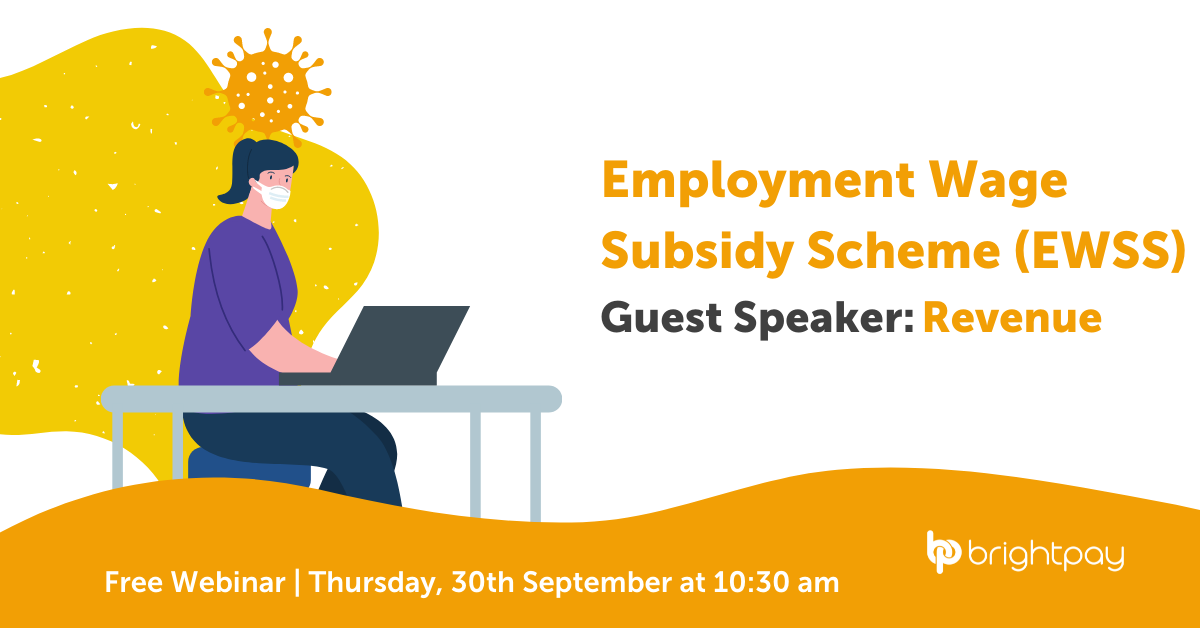
Related articles:
Aug 2021
19
Sick pay comes to Ireland: How does this affect employers and payroll processors?
In Ireland, employers currently do not have any legal obligation to pay employees who are absent from work due to illness. In the private sector, it is at the discretion of the employer as to whether or not they decide to pay employees who are unable to work due to sickness.
A survey from 2019 found that only 44% of employers offered their employees some form of paid sick leave. For employees working in the public sector, The Public Sector Sick Leave Scheme was introduced in 2014. Under the scheme, public sector employees are entitled to 7 days paid sick leave within a continuous 2-year period, without having to submit a medical certificate. When a medical certificate is provided, employees are entitled to 92 calendar days of fully paid sick leave followed by 91 calendar days on half pay, subject to a maximum of 183 calendar days in a rolling 4-year period.
The effects of the COVID-19 pandemic shone a light on the need for statutory sick pay to be introduced into the private sector. Having no sick pay entitlements meant that employees were more likely to attend work, despite experiencing symptoms of COVID-19, risking passing on the virus to colleagues. Employees who were working from home also took fewer sick days during the pandemic as because they did not have to leave their homes they continued to work, despite feeling unwell. Both of these situations can be damaging to an employee’s health.
How does offering sick pay benefit employers?
When there is no sick pay scheme in place, many employees will attend work while unwell as they do not want to miss out on pay. This does not benefit either the employer or the employee. If the employee is trying to work while they are sick, they are not going to be able to be as productive as they usually would be. This could also lengthen the time it takes for them to recover from the illness and they may not be able to work to their full potential for a lot longer than it would have been if they had taken the time off needed to recuperate.
Offering employees sick pay leave can actually help reduce the number of sick days taken by employees overall. As well as getting better faster, If the employee does not come into the workplace sick, they won't spread the sickness to other employees.
What sick pay is being introduced?
Statutory entitlement to sick pay will be phased in as part of a 4-year plan beginning in January 2022 and will be paid by employers at a rate of 70% of an employee’s wage, subject to a daily threshold of €110. The table below shows how the number of sick days covered by employers will rise over the four years.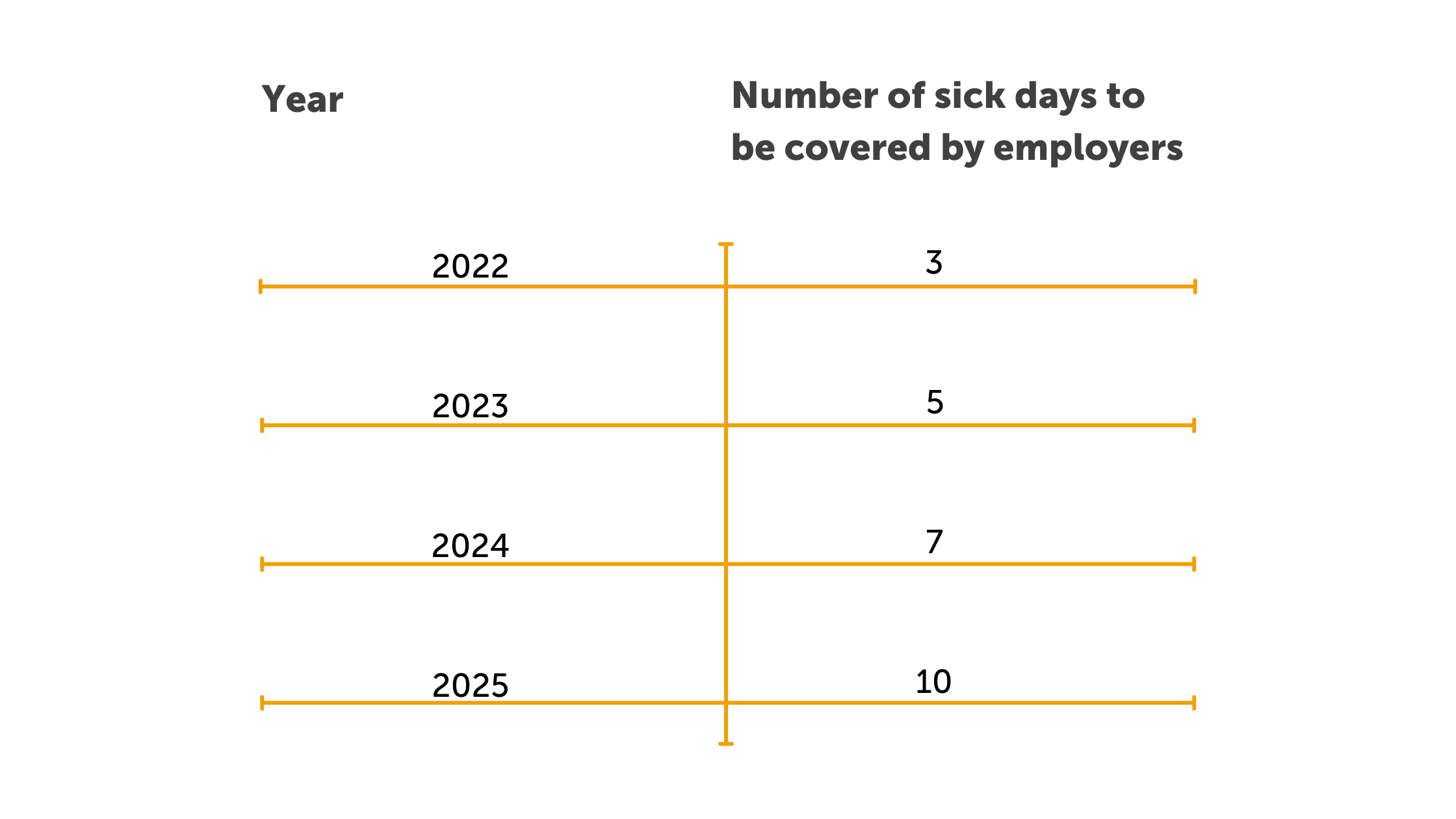
How does the introduction of statutory sick pay affect payroll?
Payroll processors may be wondering how the introduction of statutory sick pay in Ireland will affect how they calculate pay for employees who have taken sick leave. Within BrightPay payroll software, at the moment, if an employer offers paid sick leave to their employees, payroll processors can add sick pay as an ‘addition type’ within the payroll software. The employer can then manually add the amount of sick pay owed to the employee when entering the employee’s pay information for that period. The employer can add sick days taken to the employee’s calendar and choose whether these days were certified or uncertified. The days where sick leave have been taken will be colour-coded and the total number of sick days taken will be displayed on the bottom right-hand side of the screen. This means that you can clearly track the number of sick days taken by each employee.
Through our optional cloud add-on, BrightPay Connect, employees can access an online portal through an internet browser or through the BrightPay Connect mobile app. Any days taken as sick leave will be highlighted meaning that the employee can keep track of how many sick days they have taken so far that year.
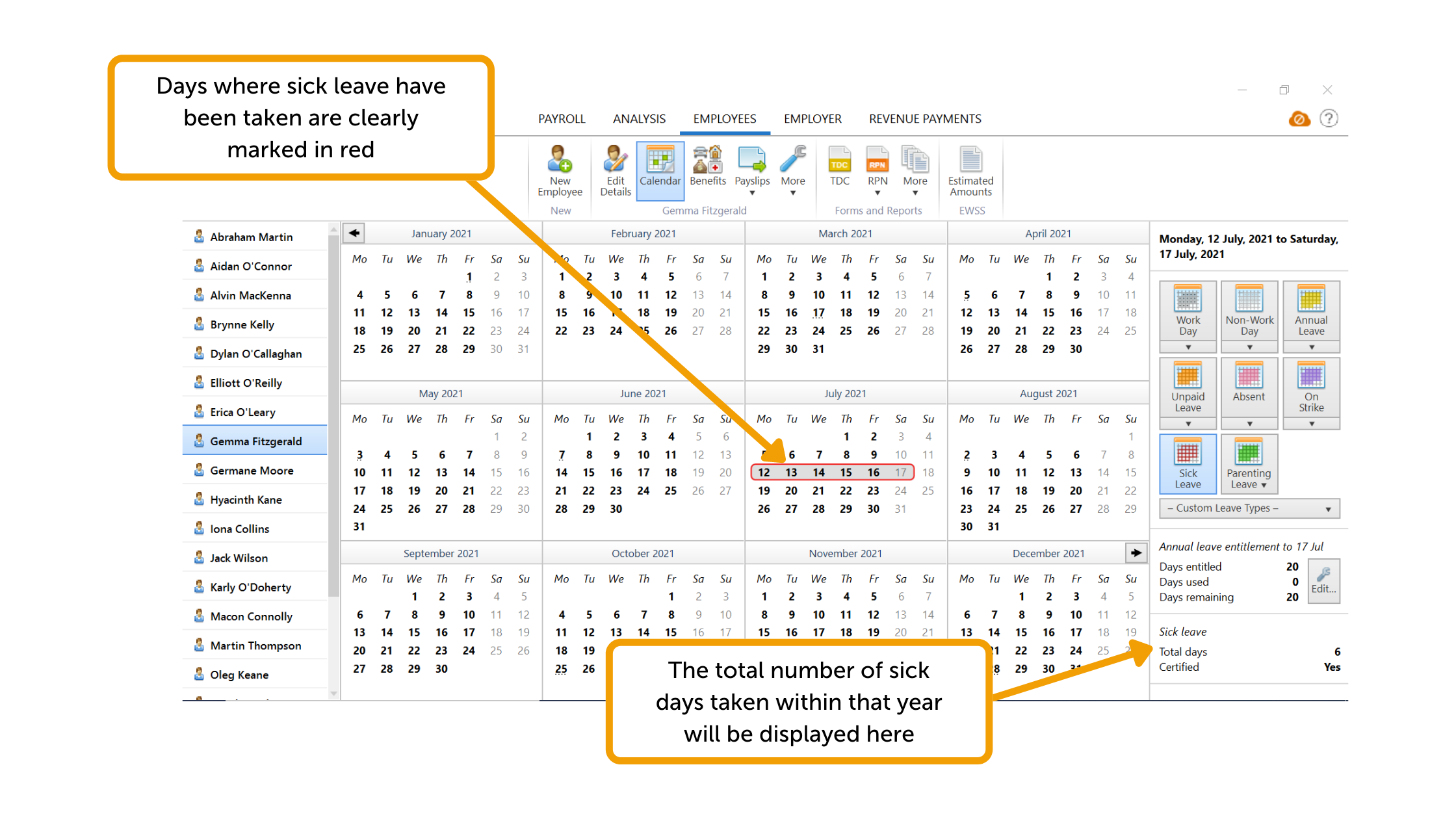
At BrightPay, through the UK version of our software, we have experience with applying sick leave entitlements to employee’s pay since 2012. Having this experience means we are well prepared to make any changes to the Irish version of our software that will make calculating and tracking an employee’s Statutory Sick Pay entitlements as easy as possible for payroll processors.
To learn more about BrightPay’s features, book a free online demo today.
Related articles:
Aug 2021
12
7 reasons why you should process payroll in-house
When we weigh up the pros and cons of outsourcing versus in-house payroll, you can see there are many benefits that your business can gain by making the switch to bringing payroll in-house. Internal staff resources can be reassigned to payroll processing to help mitigate the monetary impact of the pandemic on your business's outgoings.
Processing payroll in-house can offer financial rewards and provide several added benefits including:
- Reduced business overheads and potential cost savings
- Increased control over payroll reporting
- Internal flexibility over payroll scheduling and last-minute changes
- Minimal reduction in workload
- Streamlined HR and annual leave processes
- Self-service online access for employees
- Increased accurate reporting through API integration with accounting and bookkeeping software
Although there are some benefits to outsourcing your payroll, you can get the best of both scenarios when you choose the right payroll software.
Having the right provider for your business is crucial and can mean the difference between a laborious payroll process that you dread every pay period, and a quick and easy payroll that you hardly think about at all. But finding the right one isn’t necessarily as easy as it seems. There are so many payroll software providers today that sifting through them can be overwhelming. To make it easier for you, we have summarised the key reasons why you should use BrightPay.
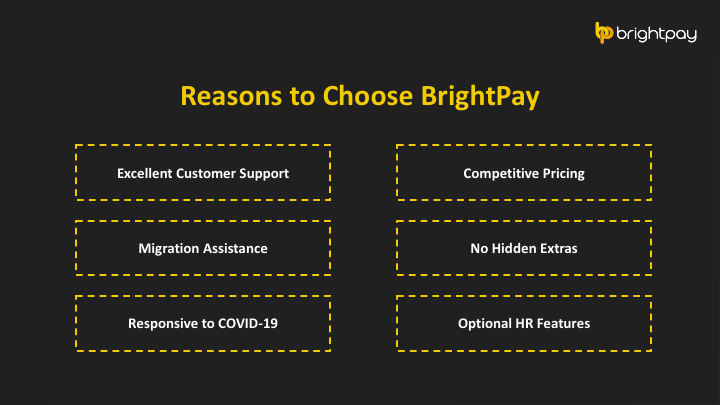
Is BrightPay the right in-house payroll software for your business? If you’re thinking about bringing payroll in-house, now could be the right time to make that transition. Get in touch and book a free 15-minute online demo.
Related articles:
Aug 2021
3
BrightPay Customer Update: August 2021
Welcome to BrightPay's August update. Our most important news this month include:
-
Watch On-Demand: EWSS Changes & The Return to Work
-
Going paperless: how an employee app can help
-
How Statutory Sick Pay will be calculated when introduced in 2022
EWSS Employer Eligibility Review Form
Revenue confirmed it has extended the deadline for the completion and submission of the EWSS Eligibility Review Form in respect of June 2021 to 15 August 2021. The eligibility review form in respect of July 2021 is also due to be submitted on the same date. Watch our webinar on-demand where we cover everything you need to know.
BrightPay’s new payroll journal integration with accounting software
We are delighted to announce BrightPay’s new API integration with AccountsIQ, Quickbooks Online, Sage Business Cloud Accounting and Xero. BrightPay users will be able to create wages journals from the finalised payslips and send the payroll data directly into their accounting software.
Statutory Sick Pay - Coming January 2022
Currently, there is no legal obligation for employers in Ireland to pay employees who are on sick leave, and it is up to the discretion of each employer. However, it will be mandatory for employers in Ireland to provide Statutory Sick Pay (SSP) for employees from January 2022.
Employee self-service app – A must-have tool for every business
BrightPay Connect gives employees access to a user-friendly smartphone and tablet app that gives them access to their payslips, HR documents, annual leave calendar and much more. Self-service apps are becoming more popular as they benefit both the employer and employee.
Adopting a hybrid working model
The COVID-19 crisis has completely shifted the way we work and live with companies having to quickly adopt new initiatives and technologies to ensure employee safety whilst maintaining productivity. Join Bright Contracts for a free online webinar on the 25 August where our team of experts will discuss how hybrid working has changed the way we work and live and what this change means for your business.
Jul 2021
30
Introducing BrightPay’s New Accounting API Features
We are delighted to announce BrightPay’s new API integration with AccountsIQ, Quickbooks Online, Sage Business Cloud Accounting and Xero. BrightPay's new payroll journal feature allows users to create wages journals from the finalised payslips for upload into specific accounting software. BrightPay will still continue to offer the option of a CSV journal.
Are APIs useful?
APIs are the little pieces of code that make it possible for software applications to talk with each other. With this direct integration, users will be able to directly send the payroll journal to the accounting package from within BrightPay. APIs make this background communication possible. So, it’s very useful for the end-user as it eliminates the need to export the CSV file from the payroll software and import it into the accounting system, saving time and reducing the risk of errors.
Interested in finding out more?
Stop copying the same figures from the payroll into your accounting software! Discover how you can free up time for you to spend on other tasks that really need your attention. Book a free 15-minute online demo now to find out more.
Related Articles:
Jul 2021
29
EWSS Eligibility Review Form
The Finance (Covid-19 and Miscellaneous Provisions) Bill 2021 was published on 23 June and extended the Employee Wage Subsidy Scheme (EWSS) to 31 December 2021. On 9 July, Revenue published guidelines to highlight the changes to the EWSS applicable for the period from 1 July 2021. The main change made to the scheme was in relation to eligibility.
Businesses who started trading before 1 January 2019 must compare their level of trade for 2021 to the level of trade for 2019 to assess their eligibility for the scheme. This will allow businesses whose trade was severely impacted due to government restrictions in the first half of 2021 to trade at higher levels for the second half of 2021 compared to 2019 and still avail of the scheme, subject to meeting the scheme conditions.
Employers must now submit monthly EWSS Eligibility Review Forms
To assist employers in ensuring continued eligibility for the scheme, from 30 June 2021, all employers will be required to complete and submit an online monthly EWSS Eligibility Review Form (ERF) through ROS. Revenue has extended the deadline for completing and submitting the EWSS Eligibility Review Form in respect of June 2021 to 15 August 2021. The eligibility review form in respect of July 2021 is also due to be submitted on the same date.
Through ROS, employers will need to provide details of actual monthly turnover or customer order values for 2019, together with the same detail for the first six months of 2021. They will also need to provide details of monthly projections for the remainder of 2021 i.e. July to December 2021.
On 15th of every subsequent month during the scheme operation, employers will need to provide details of the actual results for the previous month, together with reviewing the original projections provided to ensure they remain valid. This can be summarised as follows:
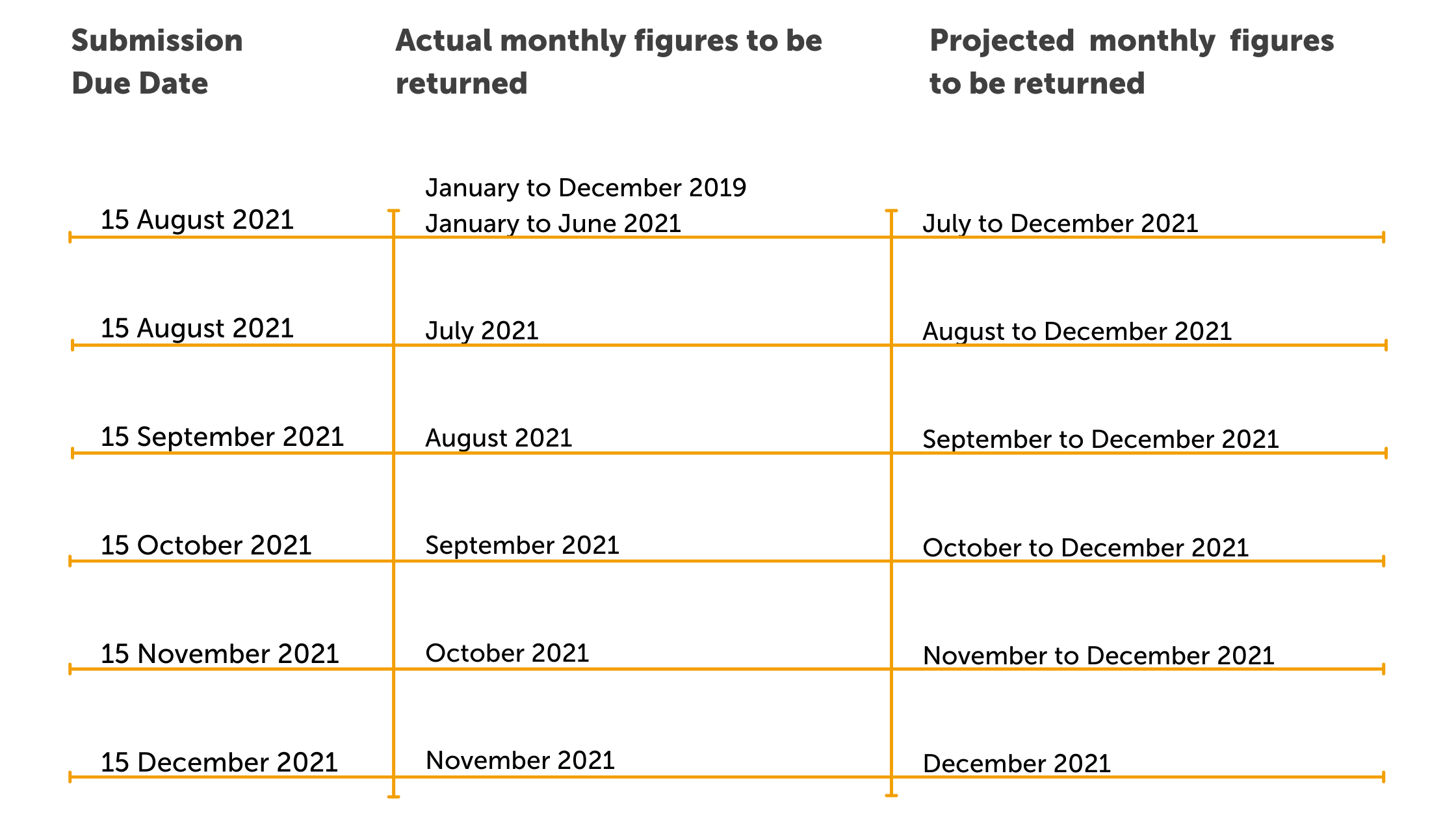
Timely submission of the electronic form will provide assurance to both employers and Revenue that subsequent EWSS claims are appropriate and in line with the terms of the scheme. This, in turn, will reduce the possibility of employers claiming EWSS amounts to which they are not entitled and having to repay those amounts to Revenue.
Childcare businesses continue to be eligible for the scheme with no reduction in turnover or orders required. However, there is a requirement for such businesses to register for EWSS through ROS prior to submitting payroll for paydates in respect of which subsidies are being claimed.
Employer Declaration
As part of the monthly submission, employers (or agents on their behalf) must sign a declaration that the information submitted is correct and accurate with best-estimate projections for future months. Failure to complete and submit the EWSS Eligibility Review Form that confirms the required reduction and related declaration will result in suspension of payment of EWSS claims.
Childcare businesses and businesses who commenced trading after 1 November 2019 will have to complete a declaration as part of the Employer Eligibility Review platform on ROS to confirm their exemption.
For more information you can read Revenue's Guidelines on eligibility for the Employment Wage Subsidy Scheme from 1 July 2021 document here.
Related articles:
Jul 2021
26
Going paperless: how an employee app can help
COVID-19 has accelerated the move to paperless systems for businesses all over the world. In retail we saw outlets curtailing the use of cash due to fear of spreading the virus; causing payment habits to evolve faster than ever. With more of us working remotely, the office has also seen rapid innovation and it has become crucial that businesses digitalise their paper forms. While some of us may have found the move to digital difficult at first, many of us are now used to it and can easily visualise a future where paper is no longer needed in the workplace. The pros of a paperless workplace far outweigh the cons and it has the ability to revolutionise the way we work.
The move to paperless is nothing new in the world of payroll processing. Going back to a time where payroll was done manually and without the help of software is unimaginable to most payroll processers. However, if you are still using paper anywhere in your workflow, it’s time to make the change.
BrightPay Connect is a cloud add-on to our payroll software that can help you to digitalise payroll and HR processes, allowing you to cut down on your use of paper and even stop using it altogether. So how can BrightPay Connect help you achieve this?
BrightPay Connect digitalises the following tasks:
- Sharing documents with employees such as contracts of employment, staff handbooks etc.
- Distributing payslips to employees
- Annual leave management
What are the benefits of digitalizing payroll processes?
1. Your company can save money
Surveys have found that the average amount spent by businesses on printing is over €800 per employee. With 30% of print jobs not even being picked up from the printer and 50% of print jobs ending up in the bin within 24 hours, businesses are essentially throwing money away. A document such as a staff handbook can be as long as 100 pages. Say you have 40 employees, that adds up to 4000 pages and a lot of money being spent on paper and ink. Sharing the staff handbook through a cloud portal cuts out this cost altogether.
2. It is more convenient for you and your employees
With BrightPay Connect, staff have the ability to access important documents through the employee self-service app on their phone. This means they no longer have to store physical documents that can often be lost or get thrown away. It also means that if you would like to update or change any of the information in the document, it is easy to do so. Once the document has been updated, employees will receive a push notification to let them know the newly updated document is ready to be viewed.
Sharing a document online with a few clicks of a mouse is far more convenient than having to print off, sort through and physically distribute reams of paper. It also doesn’t matter where an employee is; in the office, working from home, or even travelling abroad, everyone will have access to the document at the same time.
3. You can save yourself hours of time
Paper-based processes are notoriously slow and are more prone to error which can end up taking you hours to correct. One way you can save time with BrightPay Connect is by digitalising your annual leave management processes. Instead of having employees submit paper forms, the employee can request leave wherever or whenever suits them; be it from their desk or even in their own time through the BrightPay Connect mobile or tablet app.
Once a request for leave has been made, the relevant manager will receive a notification on their own BrightPay Connect dashboard. From the dashboard, employers can either approve or deny the leave request. Through your dashboard, you can view a real-time, company-wide calendar where you can see which employees are on leave, when they are on leave and the type of leave, saving you hours of time when dealing with annual leave requests.
4. It improves accountability
Another great benefit of using BrightPay Connect's online document sharing feature instead of paper is that it allows for accountability. From the employer dashboard, users have the ability to track who has read the documents which have been shared with them and who hasn’t. When it comes to managing annual leave through BrightPay Connect, you can assign users to manage requests from specific employees. You also will have a record of who has requested leave, when, and who has dealt with the request.
5. It improves security
Employee documents, especially payslips, are highly confidential documents which contain sensitive personal information. It is the responsibility of the employer to ensure that the employees' information is kept safe and secure. If you are still sharing paper payslips with employees, you are leaving them at high risk of a data breach. In the BrightPay Connect mobile app, employees will receive an email and a push notification when their latest payslip becomes available to be viewed or downloaded. From the app, employees can also view and download all historic payslips. BrightPay Connect uses a design structure that maximises security. Each user will have their own login details and unique password. BrightPay Connect utilises the Microsoft Azure platform, keeping the employee’s personal information secure.
6. It helps you stay ahead of the competition
Technology is always evolving and by not moving from manual paper processes to digital ones, you are at risk of being left behind by the competition. Companies are having to continuously innovate to keep up with customers' expectations and payroll is no different. The digital transformation has changed employees’ expectations. To attract and retain top talent, employers need to replace old manual processes with digital solutions. In a recent employee survey, 91% of employees said they want digital solutions and 88% think that technology is a vital part of the employee experience.
7. You are helping the environment
Lastly, the biggest advantage of going paperless is that you are helping to save the environment. By curtailing the use of paper in the workplace not only are you saving trees, but you are also helping to reduce pollution, save water and cut down on the use of fossil fuels which are used to make ink. Turning a single tree into 17 reams of paper releases around 110 lbs of C02 into the atmosphere. It has become the responsibility of businesses to cut down on carbon emissions and going paperless is the first step you can take.
It is becoming increasingly important for businesses to make more environmentally friendly choices. BrightPay recently conducted a survey of our UK customers and over 70% of respondents said that they would like to make more environmentally friendly decisions for their business. From the same survey, 43% said that it was either extremely important or very important for them to choose suppliers who make a conscious effort to reduce the impact they have on the environment.
Read about our own sustainability efforts here.
Why not book a free online demo of BrightPay Connect today and find out more about its benefits and how it can help your business go paperless.
Related articles:
Jul 2021
14
PAYE Modernisation – 2 years on
The new Irish PAYE system, PAYE Modernisation is now over two and a half years old. Where has the time gone? It feels like only a few short months ago that the deadline was fast approaching. It first launched on the 1st of January 2019 with the goal of delivering Real Time Reporting (RTR) in payroll and putting a bigger focus on payroll compliance for all businesses. The change was well overdue as the Irish PAYE system had no major alterations since 1960 when it was first introduced. So, with that in mind, let's look back on the impact PAYE Modernisation has had over the past two years.
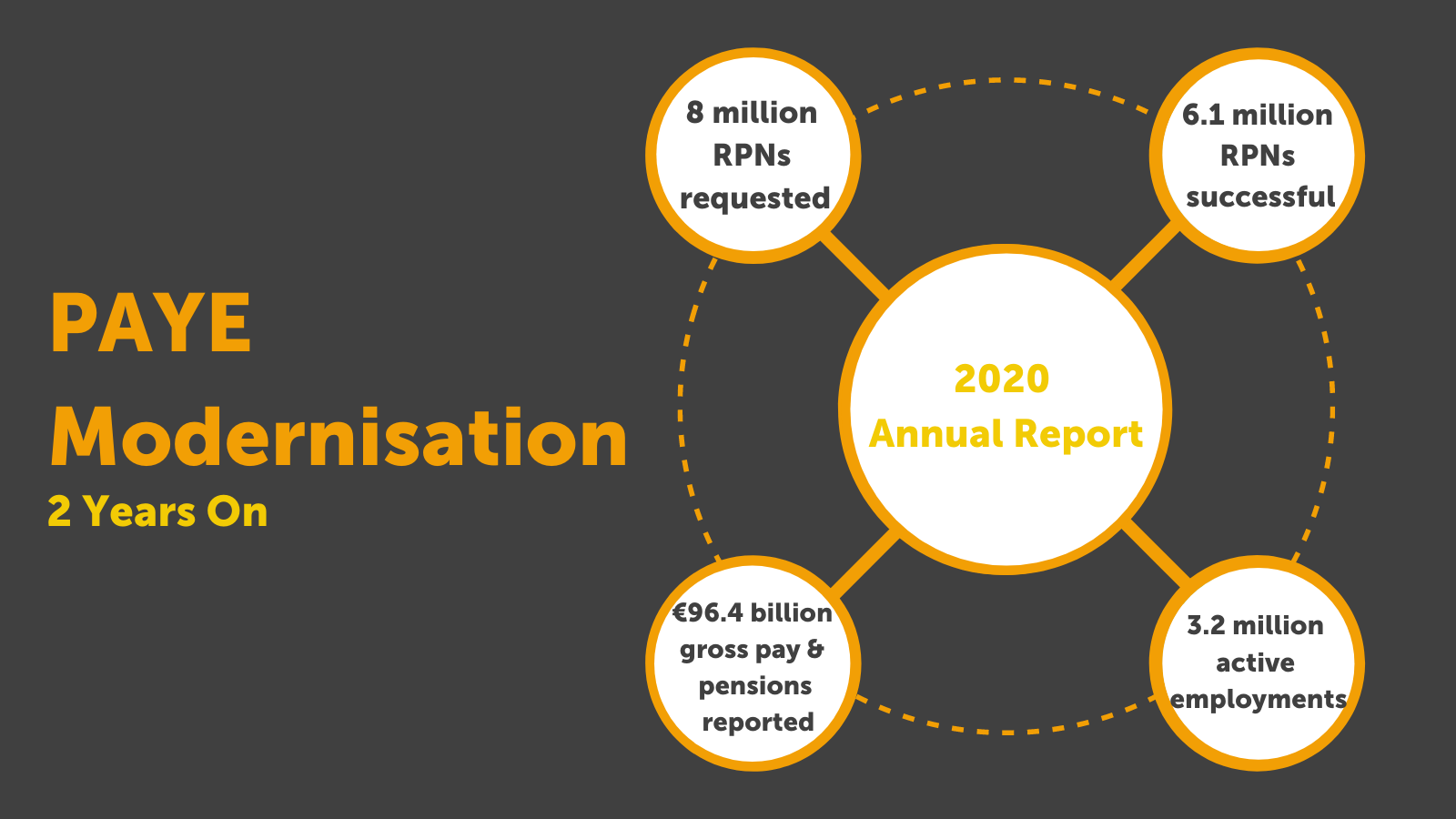
The key changes
All of the ‘P Forms’ - P30s, P35s, P60s, P45s and P46s - were abolished. These forms were previously used when an employee left a job (P45) and given a yearly statement by the employer of each employee’s annual pay and deductions (P60). They were replaced by real time submissions to Revenue. In most cases, this means a file will be submitted either weekly or monthly to Revenue by the employer or payroll processor.
The retrieval of tax credits also changed, with the introduction of Revenue Payroll Notifications (RPNs). Employers must use the most up to date RPN when calculating employees’ pay and deductions each pay period which will update any changes to an employee’s tax credit or cut-off points. This process is made easier when completed through payroll software. Revenue’s annual report released in April 2021, stated that in 2020, there were 8 million Revenue Payroll Notifications (RPNs) requested and 6.1 million successful payroll submissions.
The benefits
PAYE Modernisation has improved the accuracy and transparency of the PAYE system. It has benefited employees, employers and Revenue. Submitting information in real-time reduces tax underpayments and overpayments for employees, reduces admin work for employers and ensures that Revenue systems are accurate and up to date at all times.
Did PAYE Modernisation affect employees?
Since the introduction of PAYE Modernisation, employees can log in to Revenue (MyAccount) and view what has been submitted in relation to them by their employer. Employees can allocate their credits and cut-offs between multiple employments themselves. At the end of each year, they can view their Employment Detail Summary (formerly P60) which is automatically available to employees in January each year.
Payroll software that caters for PAYE Modernisation
BrightPay is at the forefront when it comes to PAYE Modernisation compliant payroll software. BrightPay works directly with Revenue to ensure our payroll software is fully PAYE Modernisation compliant. BrightPay ensures that the correct payroll files are produced and seamlessly submitted to Revenue. The Revenue Commissioners are strongly recommending that businesses ensure that they are using software that caters for the requirements of PAYE Modernisation. Visit BrightPay’s FAQ section where the most common questions relating to PAYE Modernisation are answered.
Discover more
Book a free 15-minute online demo of BrightPay and find out how the PAYE Modernisation process is made easier when completed through payroll software.
Related articles:
Jul 2021
9
How Statutory Sick Pay will be calculated when introduced in Jan 2022
The Government is currently drafting the Sick Leave Bill 2021 which will make it mandatory for employers in Ireland to provide Statutory Sick Pay (SSP) for employees. The sick pay scheme aims to ensure that every worker in the private sector will have the security and peace of mind of knowing that if they fall ill and miss work, they will not lose out on a full day’s pay.
Currently, there is no legal obligation on employers in Ireland to pay employees who are on sick leave, and it is up to the discretion of each employer. At present, employees in companies who do not offer sick pay can apply for Illness Benefit after 3 days of illness. Different rates apply depending on the employee’s earnings - the maximum for those earning over €300 is €203 per week. COVID-19 had a particular impact on those employees in companies where sick pay was not provided and highlighted the fact that Ireland is one of just three remaining countries in the EU not to have introduced a Statutory Sick Pay Scheme.
See statement from Tánaiste, Leo Varadkar:
“Ireland is one of the few advanced countries in Europe not to have a mandatory sick pay scheme, and although about half employers do provide sick pay, we need to make sure that every worker, especially lower-paid workers in the private sector, have the security and peace of mind of knowing that if they fall ill and miss work, they won’t lose out on a full day’s pay. I believe this scheme can be one of the positive legacies of the pandemic as it will apply to illness of all forms and not just those related to COVID-19.”
The plan is to introduce SSP over a 4-year period commencing January 2022.
The initial plan is as follows:
- 2022 – 3 days covered
- 2023 – 5 days covered
- 2024 – 7 days covered
- 2025 – 10 days covered
The rate of pay will be calculated on 70% of the employee’s wages (subject to a daily maximum of €110). Employees will need to provide a medical certificate to qualify and they must be in that employment for a minimum period of 6 months before they can qualify.
The daily earnings threshold of €110 is based on 2019 mean weekly earnings of €786.33 and equates to an annual salary of €40,889.16. It can be revised over time by ministerial order in line with inflation and changing incomes.
Once entitlement to sick pay from their employer ends, employees who need to take more time off may qualify for Illness Benefit from the Department of Social Protection subject to PRSI contributions.
Employers will need to prepare for this new legislation and update Contracts of Employment and company policies accordingly. Check out our sister product, Bright Contracts, which can help you keep contracts of employment and staff handbooks up to date with changing legislation.
Please note that the above plan has not yet been legislated on and is subject to change.
Related articles:
Jul 2021
2
BrightPay Customer Update: July 2021
Welcome to BrightPay's July update. Our most important news this month include:
-
EWSS changes under Ireland’s Economic Recovery Plan
-
The key to managing the annual leave backlog
-
Ransomware: How to protect your payroll data
Free Webinar: EWSS Changes & The Return to Work
The Employment Wage Subsidy Scheme (EWSS) has been extended until 30 December 2021. Join our upcoming webinar where we discuss the extension of the EWSS, including the new enhanced eligibility rules and what you need to know about returning to the workplace. The webinar takes place on 27 July at 10.30 am and is free to attend for all employers and payroll bureaus.
Revenue EWSS guidance is expected to be updated next week.
Bureau Branding in BrightPay Connect
Bureaus have the ability to add their own firm branding to BrightPay Connect, including the company name, company logo and contact details. The branding will be visible to clients on their self-service dashboard which will help enhance your client relationships.
Multiple Users in BrightPay Connect
Employers have the option to add as many users as they wish to their BrightPay Connect account at no additional cost. Invite managers or an external accountant as a standard user and set up user permissions for different access levels. For example, you can set up a department manager to manage employee leave, with no access to the payroll.
Automatic Enrolment Delayed until 2023
The introduction of automatic enrolment in Ireland will be delayed until at least 2023. When introduced, this will mean by law, that employers will have to enrol their employees in a workplace pension scheme.
Let’s Get Topical – The Vaccine Policy
One year on, the impact of COVID-19 on the employment landscape is hugely significant and has brought about many changes, especially the provisions of an employment contract. This is why Bright Contracts has been a saving grace for many employers as it regularly updates all contract and handbook content.
To get an insight into what Bright Contracts can do, you can watch our video and you can also download a trial version of the software first to get a look at the content and layout.
BrightPay's Sustainability Journey
Thesaurus Software, the company behind BrightPay, opened a new purpose-built office in May 2021. We have also recently established a passionate Green Team to educate, promote and inspire sustainability to our employees and our loyal customers.







